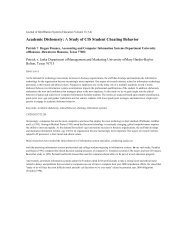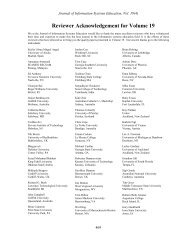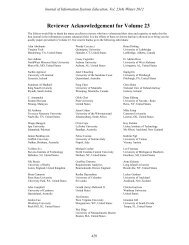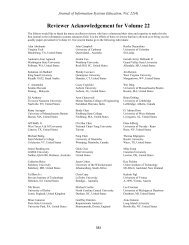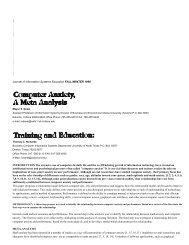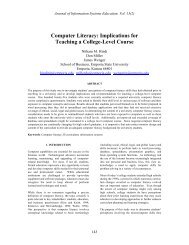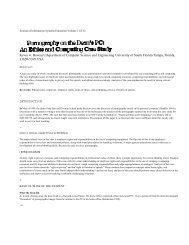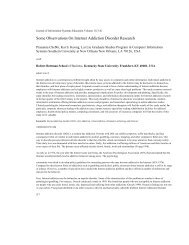Writing IS Teaching Tips - Journal of Information Systems Education
Writing IS Teaching Tips - Journal of Information Systems Education
Writing IS Teaching Tips - Journal of Information Systems Education
You also want an ePaper? Increase the reach of your titles
YUMPU automatically turns print PDFs into web optimized ePapers that Google loves.
tips in J<strong>IS</strong>E are suggesting two projects for use in a data<br />
communications course (Chen and Bradston, 2011),<br />
providing a Java Bean programming assignment (Mitri<br />
2010), using cascading style sheets to design a fly-out menu<br />
(Liu & Downing, 2010) and using a Wiki study-guide<br />
project in an introductory information systems (Lending,<br />
2010).<br />
To be a good assignment <strong>Teaching</strong> Tip, the tip must<br />
meet all the characteristics <strong>of</strong> a good tip in the next section.<br />
In particular it should report on a concrete assignment in a<br />
way that others could adopt it. The actual assignment can be<br />
provided as a figure or an appendix (e.g., Lending 2010.)<br />
The author may also wish to provide solutions to the<br />
assignment which should not be published. For example, a<br />
programming assignment <strong>Teaching</strong> Tip had solutions that<br />
were not published in the journal but are available to<br />
instructors (Mitri, 2010).<br />
This type <strong>of</strong> <strong>Teaching</strong> Tip can be similar to a <strong>Teaching</strong><br />
Case. The difference is one <strong>of</strong> purpose: a <strong>Teaching</strong> Case<br />
provides a substantial business problem that can be handed<br />
out to students; a <strong>Teaching</strong> Tip provides an innovative<br />
solution to a teaching need. The emphasis <strong>of</strong> the tip is on the<br />
improvement and how it is implemented in an instructional<br />
situation.<br />
3.2 Recommended <strong>Teaching</strong> Practice<br />
Other <strong>Teaching</strong> <strong>Tips</strong> introduce a teaching method or<br />
technique. The authors <strong>of</strong>fer advice based upon their own<br />
experience. The techniques should be specific improvements<br />
that are appropriate in information systems education.<br />
Examples <strong>of</strong> such tips are the use <strong>of</strong> crossword puzzles to<br />
teach vocabulary (Whisenand & Dunphy, 2010), the use <strong>of</strong><br />
comment-first-coding to teach programming (Sengupta,<br />
2009), and two approaches to reducing cognitive overload in<br />
teaching database (Bunch, 2009).<br />
This type <strong>of</strong> <strong>Teaching</strong> Tip is usually grounded in a need<br />
that is encountered in many courses. The need is described in<br />
detail. Examples <strong>of</strong> assignments or methods <strong>of</strong> creating<br />
assignments (e.g., Bunch, 2009) are helpful in these tips.<br />
Presenting a theory base as to why this solution meets the<br />
instructional need is a critical piece <strong>of</strong> this type <strong>of</strong> tip (e.g.,<br />
Bloom's taxonomy in Whisenand & Dunphy, 2010 and<br />
visualization in Sengupta, 2009).<br />
3.3 Recommended method <strong>of</strong> covering content<br />
The <strong>Teaching</strong> <strong>Tips</strong> that recommend a method <strong>of</strong> covering<br />
specific content are focused on how to cover a content area,<br />
usually in a specific course. The authors may <strong>of</strong>fer<br />
techniques, assignments, or technologies to cover that<br />
content. In this instance, this type <strong>of</strong> <strong>Teaching</strong> Tip may also<br />
fit into one <strong>of</strong> the other three types <strong>of</strong> <strong>Teaching</strong> <strong>Tips</strong>.<br />
Previously-published examples <strong>of</strong> this category are an<br />
introduction to a server virtualization tool that can be used to<br />
give students real-world experience in enterprise-level<br />
DBMS, (Wagner & Pant, 2010), making Web 2.0 technology<br />
meaningful to students (Lending, 2010,) or how to<br />
demonstrate public key encryption in a meaningful way<br />
(Pendegraft, 2009.)<br />
Other recommended methods <strong>of</strong> covering content can<br />
provide structure for an entire course or group <strong>of</strong> courses.<br />
One example <strong>of</strong> this is found in Peace (2011) who suggests<br />
<strong>Journal</strong> <strong>of</strong> <strong>Information</strong> <strong>Systems</strong> <strong>Education</strong>, Vol. 23(1)<br />
using debates as a method <strong>of</strong> teaching information systems<br />
ethics.<br />
Like recommended practice <strong>Teaching</strong> <strong>Tips</strong>, these tips are<br />
usually grounded in a specific need or needs that are faced in<br />
the instructional situation. However these tips focus on the<br />
content area <strong>of</strong> a specific course. In these <strong>Teaching</strong> <strong>Tips</strong>,<br />
course objectives and their importance may form an<br />
important piece <strong>of</strong> the <strong>Teaching</strong> Tip submission. In the<br />
future, this category <strong>of</strong> <strong>Teaching</strong> <strong>Tips</strong> might be linked to<br />
assessment ideas or practices for accreditation, as the<br />
publication <strong>of</strong> a <strong>Teaching</strong> Tip might provide a useful<br />
approach to gathering, analyzing, or interpreting assessment<br />
evidence especially for AACSB or ABET.<br />
3.4 Recommended technology<br />
<strong>Teaching</strong> <strong>Tips</strong> that recommend a technology are an<br />
important part <strong>of</strong> information systems education. Examples<br />
<strong>of</strong> such tips are a suggestion <strong>of</strong> low cost ERP s<strong>of</strong>tware for<br />
use in the classroom (Ayyagari, 2011), and using Twitter in<br />
online learning (Dunlap & Lowenthal, 2009.) The needs<br />
addressed in these tips differ from the other types <strong>of</strong> tips, as<br />
they may be solely focused on solving problems rather than<br />
taking advantage <strong>of</strong> opportunities. For example the Ayyagari<br />
paper (2011) solves a cost problem: how do we bring an ERP<br />
into the classroom for a reasonable cost? The Dunlap and<br />
Lowenthal paper(2009) addresses the problem <strong>of</strong> keeping<br />
students engaged in an online class. What technology can<br />
help?<br />
Good <strong>Teaching</strong> <strong>Tips</strong> on recommending technology need<br />
to be written based on the problem they are solving. For<br />
example, the tip recommending a low cost technology makes<br />
it clear what features this tool <strong>of</strong>fers compared to the features<br />
<strong>of</strong> technology tool(s) where cost may prohibit instructional<br />
adoption. The tip recommending student engagement was<br />
grounded in social presence theory and what promotes<br />
engagement.<br />
3.5 Duration <strong>of</strong> change<br />
The duration <strong>of</strong> a teaching or learning need varies and thus<br />
duration <strong>of</strong> the improvements vary. A <strong>Teaching</strong> Tip may<br />
introduce a technique that is used in a single instructional<br />
session, for example, Pendegraft's method for demonstrating<br />
public key encryption (Pendegraft, 2009). An assignment<br />
based tip might cover a single assignment or project in a<br />
course (e.g., Mitri, 2010) or multiple assignments in a single<br />
course or multiple courses (e.g., Chen & Brabston, 2010.) It<br />
may be a technique used throughout a course or in multiple<br />
courses (e.g., Whisenand & Dunphy, 2010.) The course may<br />
be structured or designed around a method (e.g., Peace,<br />
2011.) It may also be a technique that can be used across<br />
several courses (e.g., any programming course in Sengupta,<br />
2009) or types <strong>of</strong> courses (e.g. online courses in Dunlap &<br />
Lowenthal, 2011).<br />
The duration <strong>of</strong> the improvement will influence how the<br />
author writes the tip. A tip that focuses on a single<br />
assignment will be very specific to that assignment and will<br />
include detailed descriptions <strong>of</strong> that assignment. A tip that<br />
covers an entire course will have more details about the<br />
course and less on specific assignments. Evidence for the<br />
different types <strong>of</strong> tips will also vary.<br />
14



